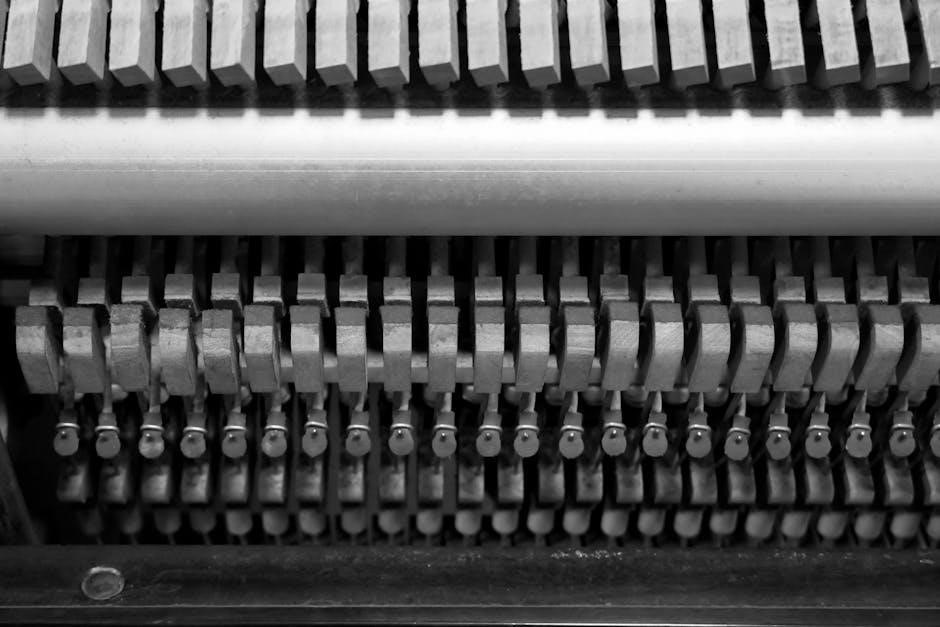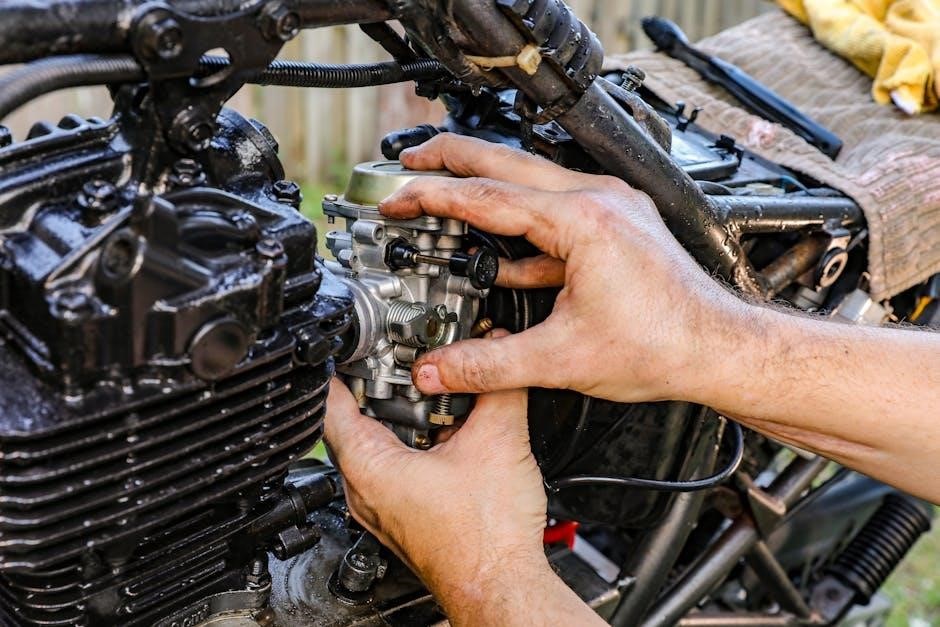Proper Mikuni carb tuning ensures optimal performance and reliability. This guide covers key aspects like air-fuel mixture, jets, and synchronization. Essential for resolving issues and enhancing engine efficiency. Perfect for both novices and experienced riders seeking precise tuning.
1.1 Importance of Proper Mikuni Carb Tuning
Proper Mikuni carb tuning is essential for achieving optimal engine performance, fuel efficiency, and reliability. Incorrect tuning can lead to issues such as poor idle, backfiring, or decreased power output. Air-fuel mixture must be precise to ensure efficient combustion, which directly impacts engine longevity and overall ride quality. Improperly tuned carbs can cause overly rich or lean conditions, potentially damaging engine components over time. Additionally, correct tuning ensures smooth transitions between throttle positions, eliminating hesitation or sputtering. For riders seeking peak performance, whether for racing or everyday use, accurate tuning is critical. Idle mixture screws and jet sizing play a vital role in achieving the perfect balance. Neglecting proper tuning can result in subpar performance, higher fuel consumption, and increased maintenance costs. Thus, understanding and implementing correct Mikuni carb tuning techniques is indispensable for any engine setup.
1.2 Brief Overview of Mikuni Carburetors
Mikuni carburetors are renowned for their reliability and performance in various engines, from motorcycles to marine applications. These carbs are designed to deliver a precise air-fuel mixture to ensure efficient combustion. They feature components like the pilot jet, main jet, and float bowl, which work together to regulate fuel flow. Mikuni carbs are popular for their adjustability, allowing riders to fine-tune settings for different conditions. The HSR tuning systems are a notable feature, enabling precise adjustments for optimal performance. Mikuni carbs are widely used in both stock and aftermarket setups, offering versatility and durability. Their design ensures smooth throttle response and consistent power delivery. Whether for off-road racing or everyday commuting, Mikuni carbs are a trusted choice among enthusiasts. This overview highlights their key features and why they remain a preferred option for engine tuning. Proper understanding of these components is essential for effective tuning.

Understanding Mikuni Carburetor Components
Mikuni carburetors consist of a float system, pilot and main jets, and an air-fuel mixture adjustment mechanism. These components work together to deliver the correct fuel flow for optimal engine performance at all RPM levels. Proper synchronization ensures smooth operation.
2.1 Determining the Correct Carburetor Size
Choosing the correct Mikuni carburetor size is crucial for optimal engine performance. The carburetor size depends on factors such as engine displacement, type of engine, airflow requirements, and intended use. A carburetor that is too large may cause the engine to run rich, while one that is too small can lead to lean conditions and poor performance. To determine the correct size, consider the engine’s cubic centimeters (cc) and its maximum RPM. For example, smaller engines typically require carburetors with smaller diameters, while larger engines need bigger ones. Additionally, high-performance engines or those with aftermarket modifications may require larger carburetors to accommodate increased airflow demands. Always consult the manufacturer’s specifications or use a carburetor sizing chart to ensure the right fit for your engine. Proper sizing ensures efficient fuel delivery, smooth throttle response, and overall engine efficiency.
2.2 Float Level Adjustment
Proper float level adjustment is essential for maintaining consistent fuel flow in Mikuni carburetors. The float level determines how much fuel is held in the carburetor bowl, directly affecting engine performance. If the float level is set too high, it can cause fuel to overflow into the engine, leading to rich running conditions and potential flooding. Conversely, a float level set too low can result in lean conditions, poor idle, and reduced performance. To adjust the float level, hold the carburetor so that the float pin is horizontal, as shown in the manual. Gently turn the adjustment screws to raise or lower the float until it aligns with the specified level. After adjustment, ensure the float moves freely without sticking. Regularly check the float level to maintain optimal fuel delivery and engine operation. Always refer to the Mikuni manual for specific instructions tailored to your carburetor model. Proper adjustment ensures smooth performance and prevents common issues.
2.3 The Role of Pilot and Main Jets
The pilot and main jets are critical components in Mikuni carburetors, each serving distinct roles in fuel delivery. The pilot jet regulates fuel flow at low RPM, such as idle and initial throttle opening, ensuring smooth transitions. A smaller pilot jet creates a leaner mixture, while a larger one enriches it. The main jet, on the other hand, controls fuel flow at higher RPM, influencing peak performance and power output. Choosing the correct main jet size is crucial for optimal engine operation, as it directly affects top-end performance and fuel efficiency. Improper jetting can lead to issues like poor idle, hesitation, or reduced power. When tuning, start with the pilot jet to establish a smooth idle, then adjust the main jet for optimal performance at higher speeds. Always refer to the Mikuni tuning manual for specific jetting recommendations tailored to your engine setup and operating conditions. Proper jetting ensures balanced performance across the entire RPM range.

Initial Setup and Preparation
Initial setup is crucial for effective Mikuni carb tuning. Begin with a clean, rebuilt carburetor to ensure proper function. Correct installation ensures accurate airflow and fuel delivery, setting the stage for precise adjustments.
3.1 Cleaning and Rebuilding Carburetors
Cleaning and rebuilding Mikuni carburetors is essential for maintaining optimal performance. Start by disassembling the carburetor, removing all jets, and soaking components in a solvent to remove dirt and old fuel residue. Use compressed air to blow out passages and ensure no debris remains. Inspect for worn or damaged parts, such as O-rings or gaskets, and replace them as needed. Reassemble carefully, ensuring proper alignment and tightness of all components. Adjust the float level to specifications to prevent fuel starvation or overflow. Test the carburetor by reinstalling it and checking for leaks or irregularities. Regular rebuilding ensures smooth operation, prevents clogging, and maintains precise air-fuel mixture delivery. Always consult the Mikuni manual for specific guidance tailored to your model. Proper cleaning and rebuilding are critical for reliable engine performance and longevity.
Installing a Mikuni carburetor requires precision to ensure proper function and engine performance. Begin by aligning the carburetor with the intake manifold, ensuring a secure fit. Use the provided gaskets to create a leak-proof seal and avoid damaging the manifold surfaces. Tighten the mounting bolts evenly to prevent warping the flange. Connect the throttle and choke cables according to the manufacturer’s instructions, adjusting for smooth operation. Ensure the fuel line is securely attached to the carburetor’s inlet to prevent leaks or fuel starvation. Reconnect any necessary electrical components, such as idle mixture screws or sensors. After installation, start the engine and check for leaks or unusual noises. Fine-tune the idle mixture screws to achieve a stable idle, ensuring proper air-fuel mixture. Refer to the Mikuni manual for specific torque specifications and cable adjustments. Proper installation is crucial for maximizing performance and reliability. Always double-check connections before initial startup. Proper tuning of Mikuni carburetors involves adjusting key components like HSR systems, idle mixture screws, and jet sizes. These adjustments ensure a balanced air-fuel mixture, smooth throttle response, and peak engine performance. The HSR (High-Speed Range) tuning system in Mikuni carburetors is designed to optimize fuel delivery at higher RPMs. It allows precise adjustment of the air-fuel mixture by modifying the needle jet and spring settings. To tune the HSR, start by determining the correct throttle opening and adjusting the needle jet to ensure smooth power delivery. Idle mixture screws and main jets also play a role in fine-tuning the system. Proper synchronization of the HSR with other carburetor components ensures consistent performance. Regular maintenance, such as cleaning and inspecting the needle jet, is crucial for maintaining optimal function. Adjustments should be made incrementally, testing the bike at high speeds to ensure the correct air-fuel ratio. A digital tuner can simplify the process, but manual adjustments remain effective. Always refer to the Mikuni manual for specific guidelines tailored to your carburetor model. Proper HSR tuning enhances engine efficiency, power delivery, and overall riding experience. Adjusting the idle mixture screw is critical for achieving a smooth and stable idle. Start by warming up the engine to ensure accurate tuning. Turn the screw clockwise to lean the mixture or counterclockwise to enrich it. Fine-tune in small increments, checking the idle quality. Proper adjustment ensures efficient fuel use and prevents engine damage. Regular checks and adjustments maintain optimal performance and reliability. Always follow manual guidelines for precise tuning. The air/fuel mixture screw is a critical component for fine-tuning the carburetor. It regulates the fuel flow at low RPM, ensuring a smooth transition from idle to mid-range power. Start by turning the screw clockwise until it lightly seats, then back it out 1-2 turns for the initial setting. Warm up the engine and listen for a smooth idle. If the engine runs rough, adjust the screw in 1/4 turn increments until it idles cleanly. For high RPM tuning, install a larger main jet if the engine feels lean. Smaller jets can be used if the engine is running rich. Always test adjustments by riding the bike under load to ensure proper performance. Proper tuning ensures efficient combustion, prevents damage, and optimizes power delivery. Regular adjustments may be needed based on weather, altitude, or engine modifications. This step-by-step process helps achieve the perfect air/fuel balance for peak performance. Carburetor synchronization ensures that all carburetors deliver the same air-fuel mixture, critical for smooth engine operation. Start by warming the engine and placing the bike on a level surface. Use a carburetor synchronization tool to measure the vacuum or airflow at each carburetor’s intake. Adjust the synchronization screws to balance the readings, ensuring even throttle response. If one carburetor is running lean or rich, it can cause poor performance or even engine damage. Fine-tune the screws in small increments, testing the engine under load to confirm balance. Proper synchronization improves idle quality, reduces vibration, and enhances overall power delivery. Regular checks are essential, especially after modifications or altitude changes. This step ensures your engine runs efficiently and reliably, delivering optimal performance across the RPM range. Synchronization is a precise process but vital for maintaining your bike’s peak condition and responsiveness. This section covers various specific tuning scenarios for Mikuni carburetors, addressing common issues, RPM-specific adjustments, and modifications for optimal performance across different riding conditions. When tuning Mikuni carburetors, common issues like backfiring, poor idle, or rough performance often arise. These problems are typically linked to improper jetting or air/fuel mixture settings. Backfiring, for instance, can occur due to a rich mixture at idle or transition. Adjusting the idle mixture screw or pilot jet size can resolve this. Poor idle quality may indicate clogged pilot jets or incorrect float levels. Cleaning or replacing the pilot jets and ensuring proper float adjustment often fixes the issue. Additionally, after rebuilding or adjusting carbs, a rich mixture can cause hesitation or stumbling. This is usually addressed by leaning out the mixture slightly or installing smaller main jets. Regular inspection of fuel flow and synchronization ensures smooth operation. Always refer to the manual or consult forums for specific solutions tailored to your setup. Systematic troubleshooting is key to identifying and resolving these issues effectively. Tuning Mikuni carburetors for varying RPM conditions ensures optimal performance across the entire power band. At low RPM, focus on the pilot jet and idle mixture screw to achieve a smooth, consistent idle and crisp throttle response. For mid-range RPM, adjustments to the needle jet and jet needle height are critical to eliminate hesitation or stumbling during acceleration. At high RPM, the main jet size and air/fuel mixture screw play a key role in delivering peak power and preventing lean conditions. Synchronization of multiple carburetors is essential for even fuel distribution at all RPM levels. Real-time testing, such as dyno runs or road tests, helps pinpoint specific adjustments needed. Regularly monitoring performance under varying conditions ensures the carburetor remains tuned for reliability and efficiency. Proper tuning enhances engine responsiveness, reduces fuel consumption, and extends the lifespan of the carburetor. Always refer to the manual or seek expert advice for precise adjustments tailored to your specific setup. Upgrades and modifications to Mikuni carburetors can significantly enhance performance, efficiency, and reliability. Common upgrades include installing larger main jets, high-flow air filters, or aftermarket needles for improved throttle response. Additionally, modifying the float level or upgrading to adjustable jets can provide finer control over fuel delivery. For high-performance applications, enthusiasts often opt for HSR tuning systems or billet carburetors for enhanced durability and precision. When considering upgrades, it’s crucial to ensure compatibility with your engine and riding conditions. Always consult the Mikuni carb tuning manual or seek expert advice to avoid over-tuning, which can lead to poor performance or damage. Small, incremental changes are recommended, allowing you to test and refine each modification. Regular maintenance and thorough testing are essential to maximize the benefits of any upgrade. Properly executed modifications can transform your engine’s responsiveness and power output, making the effort well worth the investment. Regular cleaning and inspection of Mikuni carbs ensure smooth operation. Replace worn seals and gaskets to prevent leaks. Store carbs in a dry environment to avoid corrosion. Always use genuine Mikuni parts for replacements. Regular maintenance is crucial for keeping Mikuni carburetors functioning optimally. Start by cleaning the carburetors thoroughly, ensuring all jets and passages are free from debris. Check the float levels regularly and adjust as needed to maintain proper fuel flow. Inspect the air/fuel mixture screws and idle mixture screws for wear or damage, replacing them if necessary. Additionally, synchronize the carburetors periodically to ensure smooth engine operation. Replace the fuel filter and inspect the intake manifold for leaks or damage. Always use high-quality fuel to prevent clogging the jets and internal components. For long-term storage, drain the carburetors and apply a rust-inhibiting coating to prevent corrosion. Refer to the Mikuni carb tuning manual for specific procedures and recommendations tailored to your model. Regular maintenance not only improves performance but also extends the lifespan of your carburetors. Explore Mikuni carb tuning manuals, online forums, and video tutorials for detailed guidance. These resources offer troubleshooting tips, jetting recommendations, and step-by-step installation instructions. For personalized advice, join dedicated motorcycle communities. Mikuni carb tuning manuals are essential resources for enthusiasts and technicians. They provide detailed guidance on adjusting components like jets, floats, and mixture screws. These manuals often include diagrams and step-by-step instructions for specific carburetor models. Whether you’re troubleshooting or optimizing performance, Mikuni manuals are invaluable. Many manuals are available in digital formats, making them easily accessible. They cover topics like idle mixture adjustments, main jet sizing, and synchronization techniques. Additionally, they emphasize proper maintenance practices to ensure longevity. For those working on aftermarket setups, manuals may include specific recommendations for upgraded components. Mikuni carb tuning manuals are a cornerstone for achieving precise tuning and maximizing engine performance. They cater to both novice riders and experienced mechanics, offering clear and concise information. Online communities and forums are invaluable resources for Mikuni carb tuning. Enthusiasts, mechanics, and experts share insights, troubleshooting tips, and best practices. These platforms offer real-world experiences, helping users resolve common issues like rich or lean mixtures. Members often discuss jetting configurations, synchronization techniques, and performance upgrades. Many forums feature detailed threads on specific Mikuni models, such as VM34 or HSR carbs. Users can ask questions, share modifications, and learn from others’ successes and challenges. Additionally, these communities provide access to user-generated guides, photos, and videos. They also offer recommendations for tools and equipment needed for tuning. By engaging with these forums, riders can gain practical knowledge and refine their tuning skills. Online communities are a dynamic complement to official manuals, fostering collaboration and continuous learning in the Mikuni tuning world. They are a go-to resource for staying updated on the latest techniques and trends.3.2 Installing the Mikuni Carburetor

Tuning Components for Optimal Performance
4.1 HSR Tuning Systems
4.2 Idle Mixture Screw Adjustment
4.3 Air/Fuel Mixture Screw Tuning
4.4 Carburetor Synchronization

Specific Tuning Scenarios

5.1 Troubleshooting Common Issues
5.2 Tuning for Different RPM Conditions
5.3 Upgrades and Modifications

Maintenance and Care

6.1 Regular Maintenance Tips

Additional Resources
7.1 Mikuni Carb Tuning Manuals

7.2 Online Communities and Forums
Proper Mikuni carb tuning is essential for achieving optimal engine performance, efficiency, and reliability. By following the guidelines outlined in this manual, riders can ensure their carburetors are correctly sized, adjusted, and maintained. Understanding components like pilot and main jets, float levels, and synchronization is crucial for precise tuning. Regular maintenance and troubleshooting common issues will extend the life of the carburetors and enhance overall engine functionality. Whether upgrading, modifying, or fine-tuning for specific conditions, this manual provides a comprehensive foundation. Remember, tuning is a process that requires patience and thorough testing. Always consult official Mikuni resources and seek advice from experienced enthusiasts in online forums for additional support. With dedication and practice, riders can master Mikuni carb tuning, unlocking their engine’s full potential. Stay informed, experiment responsibly, and enjoy the rewards of a perfectly tuned machine.


